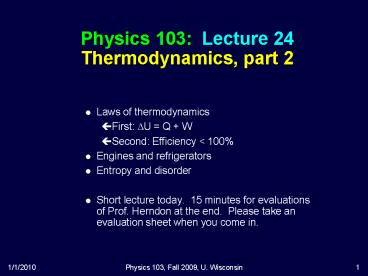Physics 103: Lecture 24 Thermodynamics, part 2 - PowerPoint PPT Presentation
1 / 19
Title:
Physics 103: Lecture 24 Thermodynamics, part 2
Description:
... DS, between two equilibrium states is given by the energy, Qr, transferred ... room (assume that room and its contents are isolated from rest of the universe) ... – PowerPoint PPT presentation
Number of Views:37
Avg rating:3.0/5.0
Title: Physics 103: Lecture 24 Thermodynamics, part 2
1
Physics 103 Lecture 24Thermodynamics, part 2
- Laws of thermodynamics
- First DU Q W
- Second Efficiency lt 100
- Engines and refrigerators
- Entropy and disorder
- Short lecture today. 15 minutes for evaluations
of Prof. Herndon at the end. Please take an
evaluation sheet when you come in.
2
Applications of the First Law Adiabatic Process
- Adiabatic process
- Energy transferred by heat is zero
- The work done is equal to the change in the
internal energy of the system - One way to accomplish a process with no heat
exchange is to have it happen very quickly.
Another way is to keep the system isolated. - In an adiabatic expansion, the work done is
negative and the internal energy decreases
Adiabatic compression, pos work - Important in the Heat engine - Carnot cycle
- PV? C, ?CP/CV
- ? adiabatic index
- Molar Specific heats
- CP heat transfer
- CV change in internal energy
3
Heat Engine.
- Based on cyclical process, DU 0
- Its initial and final internal energies are the
same - Therefore, Qnet Weng
- The work done by the engine equals the net energy
absorbed by the engine - The work is equal to the area enclosed by the
curve of the PV diagram
4
Carnot Cycle
5
Q DU - W
Q DU - W
6
Heat Engine Efficiency vs. Refrigerator
Coefficient Of Performance
7
Heat Engine Carnot Cycle
No real engine operating between two energy
reservoirs can be more efficient than a Carnot
engine operating between the same two
temperatues. - Sadi Carnot
8
Heat Pumps Refrigerators
Adiabatic expansion
Heat engines operated backward Work done to
transfer heat from cold to hot reservoir Reverse
path in the PV diagram compared to Carnot
cycle Carnot cycle is a reversible process
9
Real Engines vs Carnot Engines
- All real engines are less efficient than the
Carnot engine - Real engines are irreversible because of friction
- Real engines are irreversible because they
complete cycles in short amounts of time
10
Entropy
- A state variable related to the Second Law of
Thermodynamics, the entropy - The change in entropy, DS, between two
equilibrium states is given by the energy, Qr,
transferred along the reversible path divided by
the absolute temperature, T, of the system in
this interval - When energy is absorbed, Q is positive and
entropy increases - When energy is expelled, Q is negative and
entropy decreases - Can also be thought as an increase in disorder
11
More About Entropy
- Note, the equation defines the change in entropy
- The entropy of the Universe increases in all
natural processes - This is another way of expressing the Second Law
of Thermodynamics - There are processes in which the entropy of a
system decreases - If the entropy of one system, A, decreases it
will be accompanied by the increase of entropy of
another system, B. - The change in entropy in system B will be greater
than that of system A.
12
Second Law of Thermodynamics
- Heat cannot be transferred spontaneously from
cold to hot - No engine operating between two reservoirs is
more efficient than a Carnot engine - Systemenviroment Qc/Tc?QH/TH
- Qc/QH ? Tc/TH (equal for Carnot)
- Eff 1 - Qc/QH ? 1 - Tc/TH (equal for Carnot)
- No disordered state cannot spontaneously
transform into an ordered state - The entropy change (Q/T) of the
systemenvironment ? 0 - Entropy change 0 for Carnot
13
Extra
14
Question
- Heat is applied to ice-water mixture and a
portion of the ice melts. Which of the following
quantities increase? - The mixtures temperature and internal energy.
- The mixtures temperature and entropy.
- The mixtures entropy and internal energy.
- The mixtures temperature, entropy and internal
energy. - None of the above three quantities increase
Temperature remains constant during the melting -
heat goes into increasing energy for ice
molecules to free themselves from neighbors and
flow as water. Since there is heat flow into the
mixture, its entropy also increases.
15
Adiabatic Compression
- During adiabatic compression of an ideal gas, the
entropy of the gas - Decreases.
- Stays constant.
- Increases.
No heat is transferred in or out of the system
during an adiabatic process - therefore, entropy
remains constant.
16
Entropy Question
- Suppose your roommate is Mr. Clean and tidies
up your messy room after a big party. What
happens to the entropy of the room (assume that
room and its contents are isolated from rest of
the universe)? - Decreases
- Stays the same
- Increases
The books may be in order after the cleanup, but
the work done by your roommate generates heat,
resulting in increase of the rooms entropy.
17
Perpetual Motion Machines
- A perpetual motion machine would operate
continuously without input of energy and without
any net increase in entropy - Perpetual motion machines of the first type would
violate the First Law, giving out more energy
than was put into the machine - Perpetual motion machines of the second type
would violate the Second Law, possibly by no
exhaust - Perpetual motion machines will never be invented
18
Heat Engine
19
Carnot Cycle































